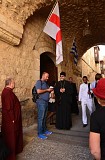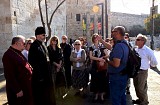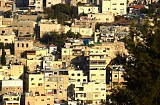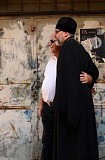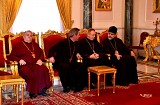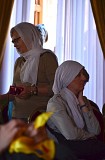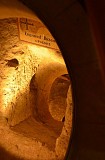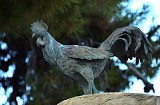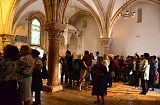Pilgrims of the Ukrainian Orthodox Church of the USA Fulfill the 6th day of their Pilgrimage to Holy Land
Шостий день паломництва паломників Української Православної Церкви УПЦ США на Святу Землю
Reflection and Photos by Elizabeth Symonenko, Consistory Secretary
The morning began early with the roosters crowing, the birds singing, and the pilgrims from the Ukrainian Orthodox Church of the U.S.A. eager to see what the day held for them. We got our first glimpse of the Mount of Olives, and the countless graves, as we made our way to the first stop of the day which would prove to be one of the best known sites in Jerusalem – the Wailing Wall, known as such because the Jews mourn the destruction of the Temple.
The wall was built by Herod the Great as the retaining wall of the Temple Mount complex. The Wailing Wall is the outermost site and last remnant of King Solomon's original Temple, which housed the Ark of the Covenant over 2,000 years ago. This is one of the reasons it is consider sacred by the Jewish population. They believe that once the Ark of the Covenant was destroyed, the Holy Spirit which resided within the Ark, found a new home in the Wailing Wall.
His Eminence Archbishop Daniel watched from above, as his little flock approached the wall for a closer look. The men, who were required to cover their heads, went to the left and the women to the right. Many of us stopped at little tables which were set up along the sides, and wrote out little prayer requests that were then squeezed in to the cracks between the limestone blocks of the wall. Personally, I was impressed merely with the fact that I was viewing a wall that has stood for millennia. I could picture in my mind the countless individuals whom had walked past this very wall. However, as impressive as that thought was, the entire site seemed much smaller than I had envisioned from having viewed it through various media sources.
One by one we gathered around Archbishop Daniel, and when the count once again reached 19, Khalil Haddad, our guide, led us back through the entry point, and to the bus to drive a short distance to begin our long day’s excursion. As we drove past school children carrying their books, vendors hawking their wares, people rushing about their daily affairs, Khalil asked us to quickly look out the left window. As we craned our necks to get a look at some fascinating structure, some wondrous location, all we spied was a small little valley with various ancient structures peppered throughout. This is the Gehenna from which the Bible gets the name for Hell. Gehenna is a place outside ancient Jeruslaem, which is also known in the Bible as the “Valley of the Son of Hinnon”. This valley surrounds Jerusalem’s Old City, including Mount Zion, and merges with the Kidron Valley. This valley is known to be the place where kings of Judah sacrificed their children by fire. In the Bible, Gehenna is the destination of the wicked. Having viewed the seemingly innocent looking valley, it made me stop and think, that often what we see externally is one thing, but, what lies beneath is completely different. All chit chat and banter stopped in the bus, as we all gazed upon the valley, realizing the horrors that must have taken place there in order to have the Bible refer to Hell after this very spot.
We were grateful when Hamid, our driver, pulled over to let us off the bus, so we could view something cheerier and dispel the dark mental pall that hung over us. Our dark moods quickly dissipated as we found ourselves standing in the sunshine, next to a large and ancient gate. This was the Gate of Jaffa, which would quickly turn out to be one of our favorite places on the tour, as it led us to the Old City. The Jaffa Gate is a stone portal in the ancient walls of the Old City of Jerusalem. It is one of eight gates in Jerusalem's Old City walls. It is the only one of the Old City gates positioned at a right angle to the wall. This could have been done as a defensive measure to slow down oncoming attackers.
We entered the centuries old edifice and emerged in a wonderland. Stone paved streets and sidewalks, with shops, alleyways, and cafes. With instructions to “stay together” we entered the hubbub and with eyes wide open, trying to absorb all the motion about us, we made one quick turn and found ourselves in an alleyway, leaving behind all the noise and commotion. We zigged and then zagged and made our way through quaint roads, and alleys with flowers blooming, cats lazily napping, ancient doors inviting, laundry drying, and birds chirping until we arrived at a portico and came to a stop. We were about to have an audience with the Patriarch of Jerusalem, Theophilos ΙΙΙ, Patriarch of the Holy City of Jerusalem and all Palestine and Israel. As we waited to be granted admittance we watched in amazement as men pulled carts along the alleyway, motorcycles whizzed past and as other faithful gathered to wait along with us. Eventually a man with a rather large key arrived and let us in to what seemed as yet another world.
We left behind the mundane and entered a place of pageantry and royalty befitting a Patriarch of Christ’s Church. We were hushed by the grandeur of the white marble steps, the majestic icons in their gilded frames, and mostly by the realization that we entered a place that few people get to see. Having first stopped at the Patriarch’s Chapel located on the right, we continued on to the audience room. It was like entering a dream. His Eminence Archbishop Daniel, along with our clergy, headed to the front of the room to take up their seats. The rest of us, uncertain what to expect, took up seats along the back of the room. Taking photos has its perks, as I was asked to come forward, and eventually alighted on a seat against the wall, just across our clergy. As we waited the Patriarch’s arrival, I was mesmerized by the room, and the significance of being in this place. I sat back in my overstuffed, red cushioned, gold gild framed chair, with a huge grin upon my face and realized just how privileged we all were to be here.
Of all the thoughts that could have occupied my mind at this point, I took a moment to relive my own personal history. Tears filled my eyes as I recollected how my ancestors had valiantly persevered all manner of hostility, violence and even death in the name of God and His Church. I relived how the KGB had broken in to my mother’s home in Ukraine, at 2 a.m., after she at age 5 had mentioned on the playground that her grandmother speaks with God daily (prays). I remembered how they had to hide their icons, and Bible in false bottomed chests, how they prayed in secret, and how they fought not to lose the Faith, from generation to generation. I recalled how my family having found themselves in Brazil, were active in building a Ukrainian Church in Porto Alegre, how my uncle wrote the icons, my grandfather chiseled the Royal Gates, and my mother did everything in between. I remembered how up to one month prior to his death, my uncle and godfather served the church as the Starosta, selling candles, and serving in the Altar; and how my mother, even though sick, frail and in pain, insisted upon going to church every Sunday, having only missed her final Sunday on earth...and then I looked up and realized where I was sitting and I was so very very humbled and unworthy to be in this dignified place, and yet, I could imagine how my ancestors were looking down upon us and were smiling, that not only I, but, the faithful, hierarch and clergy of our Ukrainian Orthodox Church of the USA were sitting in Jerusalem, and awaiting to meet with the Patriarch.
The room had filled with a number of groups from various ethnic and national backgrounds. The room was filled to standing room only, and suddenly became hushed as the Patriarch appeared and entered the room and made his way forward. He greeted Archbishop Daniel first, then turned and greeted everyone else present. Once we all resumed our seats, men appeared with trays, offering each of us refreshment in the form of fresh juice and candies.
We sat back and listened as the Patriarch spoke in English, and his words got translated into Russian for there were many Russians in the audience. His Beatitude greeted us all warmly, thanked us for coming to Jerusalem, and then he went on to speak about the Church in general. He spoke how the world is being impacted by environmental changes, how the faithful are being impacted by societal changes, and how crucial it is for us to not only preserve the Faith, but, we need to be as the Apostles and go out in to the world and teach the Faith, even to those who claim to already have it. He stressed how important it is for us to return to our homelands and speak to others about what we saw and witnessed. How we felt at the Lord’s tomb, how we were affected at the spot of the Nativity and how our lives will never be the same. I did not yet grasp the deeper meaning of His Beatitude’s words at the time, but, all he said could not have been truer. He reminded us that since we have been “given more”, by having had the opportunity to witness firsthand the holy sites of God, and to have been able to be transformed by what we saw, touched and felt, that more was now expected of us. It was now our duty to take what we have been freely given by Christ, and go out to the world and spread it to others. The Patriarch expressed his concern over how we are losing our faithful to secularity, apathy and to the general loss of morals and ethics of society. He concluded by asking us to do our part in preserving, and growing the Faith.
Upon concluding his address, His Beatitude stood and adorned His Eminence Archbishop Daniel with a new Mother of Pearl Panagia and Pectoral Cross. Having also gifted crosses to our clergy, he stood to receive the faithful and give each one his blessing. Having taken a group photo, we all made our way back down the marble steps, and still in awe emerged back in to the paved alleyway, leaving behind the pageantry and otherworldliness, and yet taking a bit of it along with us, in our hearts to go and spread to the world.
Having left the Patriarchate of Jerusalem, we walked a short ways, climbed a few steps and found ourselves in what is known as the “Upper Room”. The upper room is mentioned in the Bible as the place where the Mystical Supper took place. It is located directly above what is believed by some to be the Tomb of David, near the Dormition Abbey on Mount Zion. The current structure was built in the 12th century and while that means it is not the original location, it is strongly believed to be either near the proper spot, or actually simply rebuilt over the same location. Beneath the floor of the building are Byzantine and Roman pavements and the foundations go back to at least the 2nd century AD. It is almost stark in its simplicity: a Gothic vaulted ceiling, stairs leading to an inner room, a carved marble niche, and a symbolic bronze olive tree on a raised platform (symbolizing the commonality of the Messianic Faiths), which was a gift to the Holy Land from Pope John Paul II during his pilgrimage there. The tree is supposed to symbolize that the three Faiths: Christianity, Judaism and Islam all have a common thread, and worship the same God. To my understanding this is incorrect, however. Unless a Faith propones to believe in the Holy Trinity, they do not worship the True God of Christianity - which would require the belief that Christ, the Son of God, is the Messiah.
Having left the Upper Room, we walked downstairs to visit what some believe to be the Tomb of David. With men going one way, and women the other, we shuffled past a shrouded casket, paying our respects to King David.
Everything in Jerusalem is uphill, so we once again began our ascent until we reached Church of St. Peter in Gallicantu (cock's-crow), which is a Roman Catholic church located on the eastern slope of Mount Zion, just outside the Old City of Jerusalem. It is believed to be the spot where St. Peter rejected Christ, enacting Christ’s prediction that by the time the rooster crowed twice, Peter would have denied even knowing him three times.
We walked inside and went downstairs to what seemed like an inconsequential “hole” in the floor, surrounded by a railing. However, this location proved to be rather an eye-opener. It was marked by ancient Byzantine Crosses, and Khalil explained to us that this is most likely the spot where Christ was bound and where he spent the night until the morning’s trial. One would envision a man with tied hands sitting on a bench, peacefully awaiting what lay ahead. However, it seems this too would be incorrect. Christ was bound and then lowered to the chamber below by ropes (see photo), trussed up hand and foot so that he could not even move. Once lowered in to the chamber below, he would not have been able to raise his hand to wipe his brow, or shift his weight off his aching side, or move his leg that was cramping up. The horror of this realization, made his sacrifice for us all the more poignant. With this new realization weighing heavy on our hearts we found it almost hard to breath as we descended to the chamber below, realizing how Christ had suffered on our behalves. The chamber was small, intimate and suffocating, and our hearts were breaking just contemplating the agony that took place there, accentuated by His Eminence reading the Gospel passage. With his words echoing off the stonewalls, they seemed to bite and snap at our hearts, until we could breathe no longer, and were eager to climb out of the darkness, seeking refuge in the sunlight above.
We all eagerly clambered out onto a terrace, looking for respite from the heaviness we were experiencing, but, none was to be had at that moment. Below us were the ruins the House of the Priest Caiaphas, where Christ had been taken that same evening, and it was here that Jesus was tried informally by the Sanhedrin. We quietly shuffled past the ruins, still looking for respite and found ourselves in a tiny courtyard with a statue of St. Peter being questioned by the girl and with raised hand and furrowed brow, Peter insisted he did not know this man named Jesus. The whole scene was a whirl of fear, condemnation and loss. The strongest and most committed figure on the statue was the rooster standing above the turmoil, resolutely enacting that which God had instructed him to do. His stance was solid, with one leg forward for balance, as he determinedly crowed while his heart too must have been breaking.
With tears shining in our eyes we tried to escape the situation, and moved further…away from the betrayal, that we too feared we may have well committed if we were found in that same situation. We wished to escape human frailty, vanity, insecurity, and lack of trust in God, and we moved to our left, trying to distance ourselves from that which we feared within ourselves. But, alas, there was more to come, as we glanced down at some white stone ruins through an iron fence. They seemed innocent enough with grass growing over them, and then we were informed these were the first steps Christ took as he began his journey to Golgotha. That realization shook us all as we looked forlornly down upon that which creation had done to its Creator. With tears freely flowing now, we no longer tried to escape the situation, but, were mesmerized and frozen in spot, with the horror of it all seeping into our very core. That gut wrenching feeling revealed to us our own frailty and yet it encouraged and strengthen our resolve, that we should not enact this crime against God, even in our daily lives and how we live them.
With eyes stinging we moved away to the side to take a look at the vista before us. It was as if the world lay to our right, left and center. Homes covered the hillsides, as people lived out their lives, eating, loving, arguing, cooking…and the mundane daily tasks we all enact daily, with little regard to Christ and what he went through. Even this small realization, the homes filled with people like us, doing things like us, just a shadow away from the place where Christ was tortured, was a mirror for us and our lives, and committed us to leave this place as better people, worthy to be called Christians.
Our final stop of the day was at a Romanian Orthodox Church, which following the New Calendar had already embarked upon the Nativity Fast. We were warmly greeted and the beautiful icons, the scent of incense, and the kind words of the priest, returned us to a sense of calm and renewed our hopes. The priest welcomed us to Jerusalem and to his church. He gave us a short history lesson of not only his parish, but, Romanians in Jerusalem, and as the Patriarch did, so he reminded us to take Jerusalem back with us in to the world. We are not here as tourists, but, as pilgrims, and as such it is required of us to share and spread that which we have seen, learned and experienced with the rest of the world, and to work towards salvation of all.
By the time we reached the hotel this night, we were tired, burdened, saddened, and yet we were strengthened, filled with hope and joy, because we were not alone, we had each other, and we had Christ to lead us and help us, and we were determined to do as we had been repeatedly instructed today. Having had a good dinner, and having bolstered each other up with good conversation and camaraderie, we found refuge in our beds, looking for rest, knowing full well that each new day brought us new challenges, but, also new rewards. We were eager to see what lay ahead of us tomorrow.
Day 6- Pilgrimage to Holy Land 2016 - 11/17/2016
Photos by Elizabeth Symonenko
(76 images)
|
| |||||||||||||
